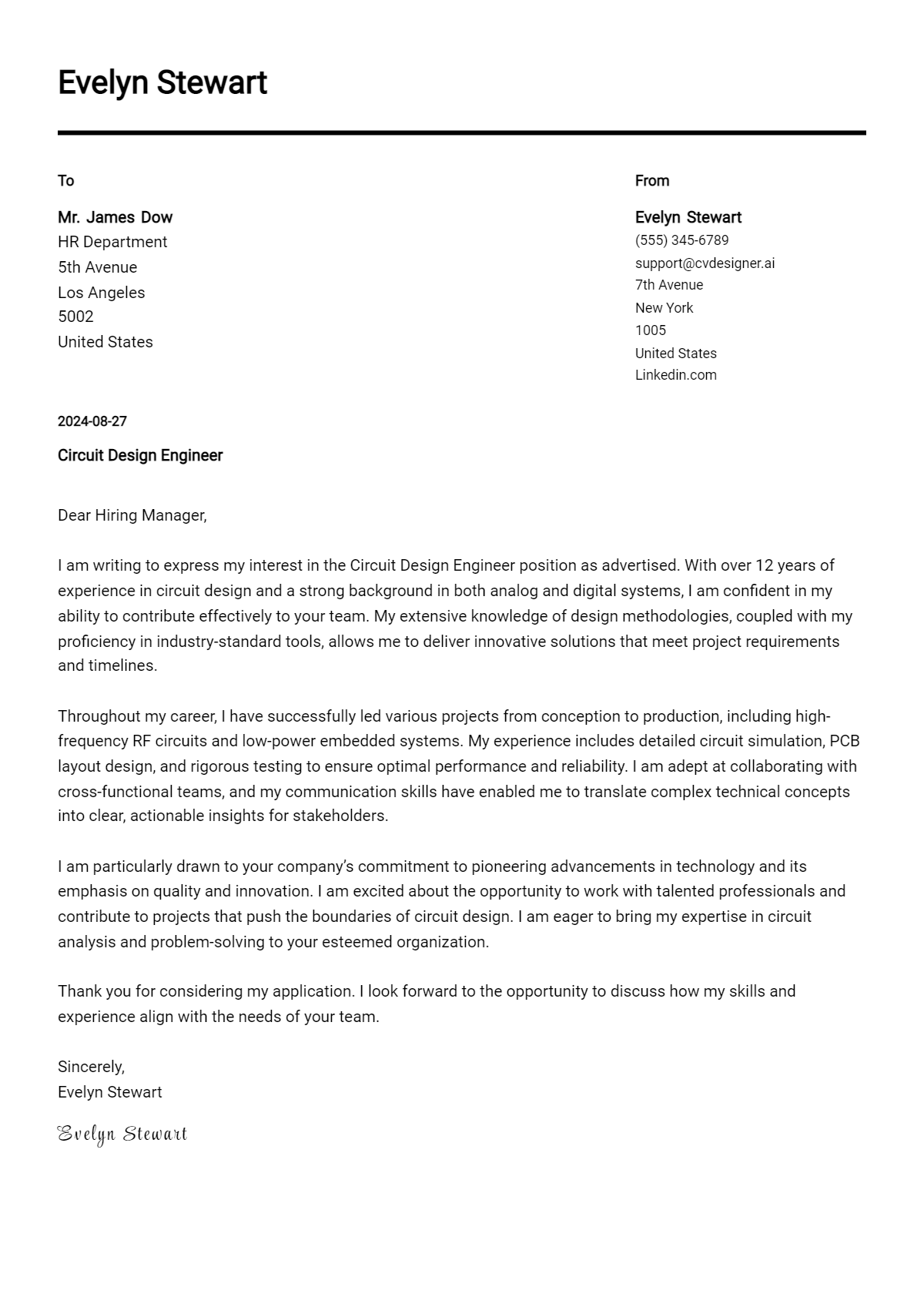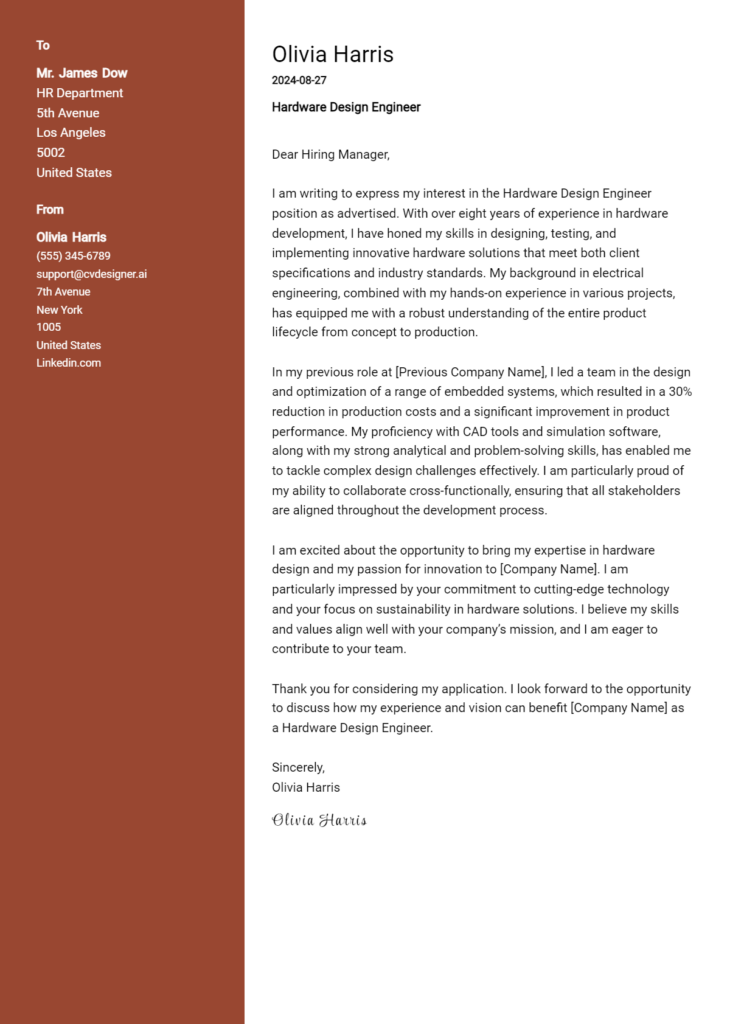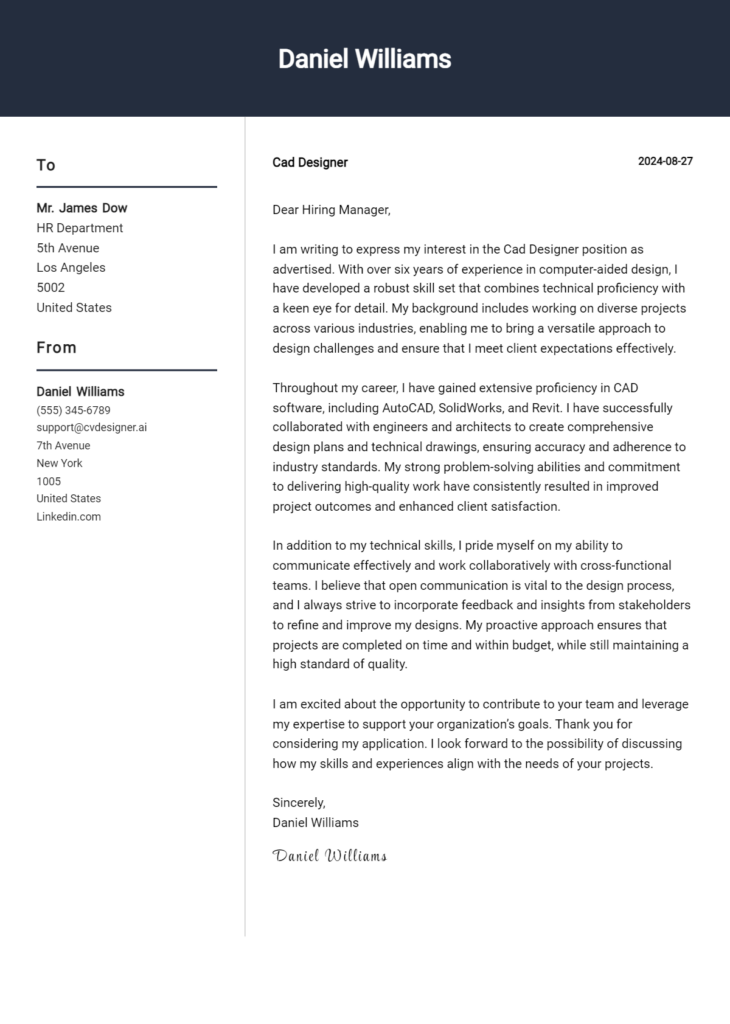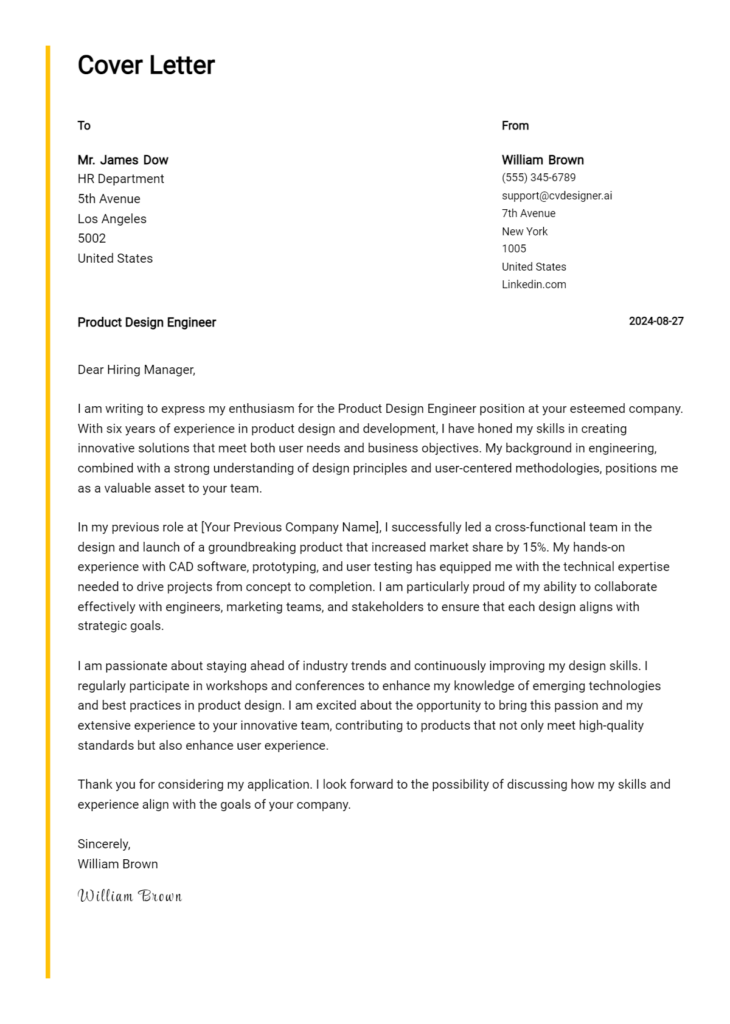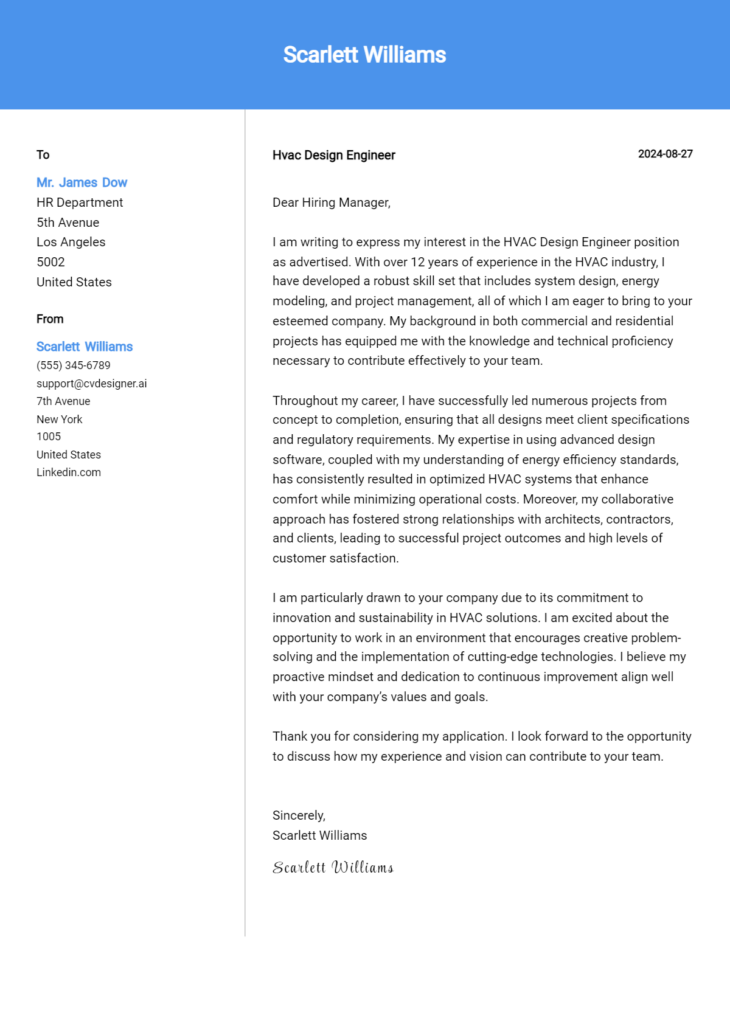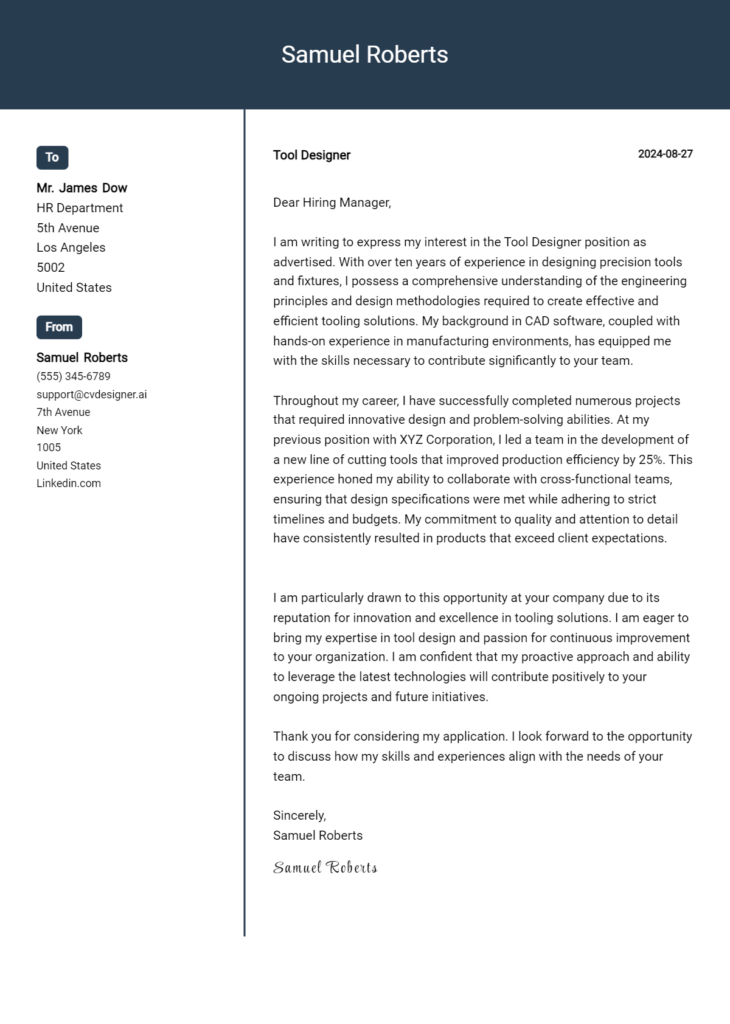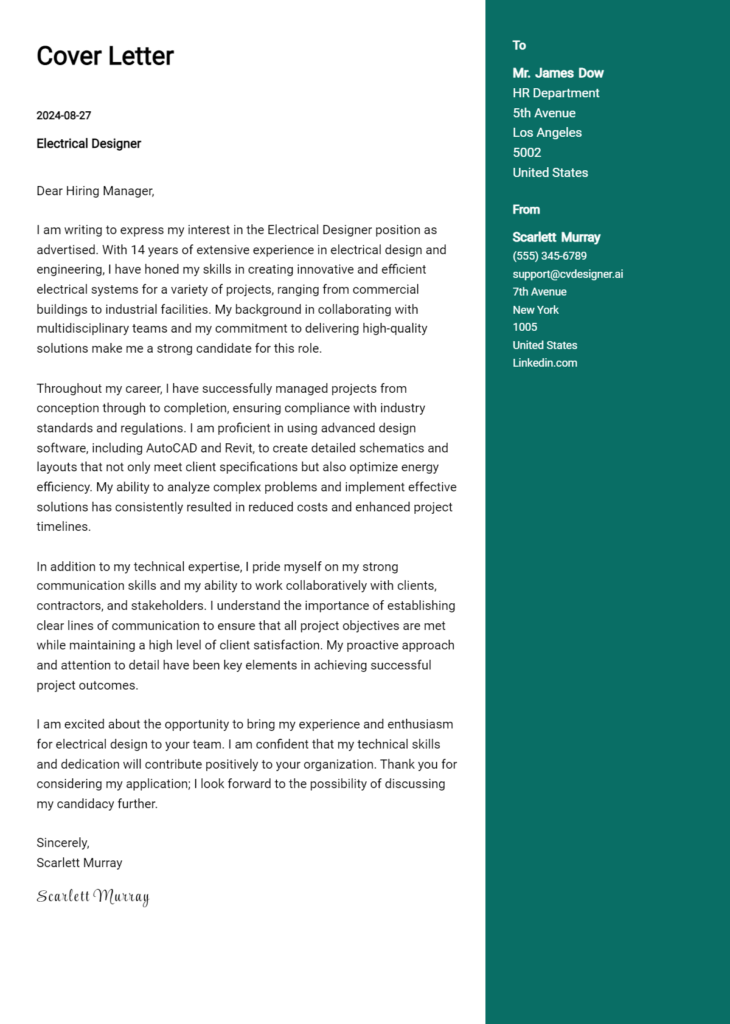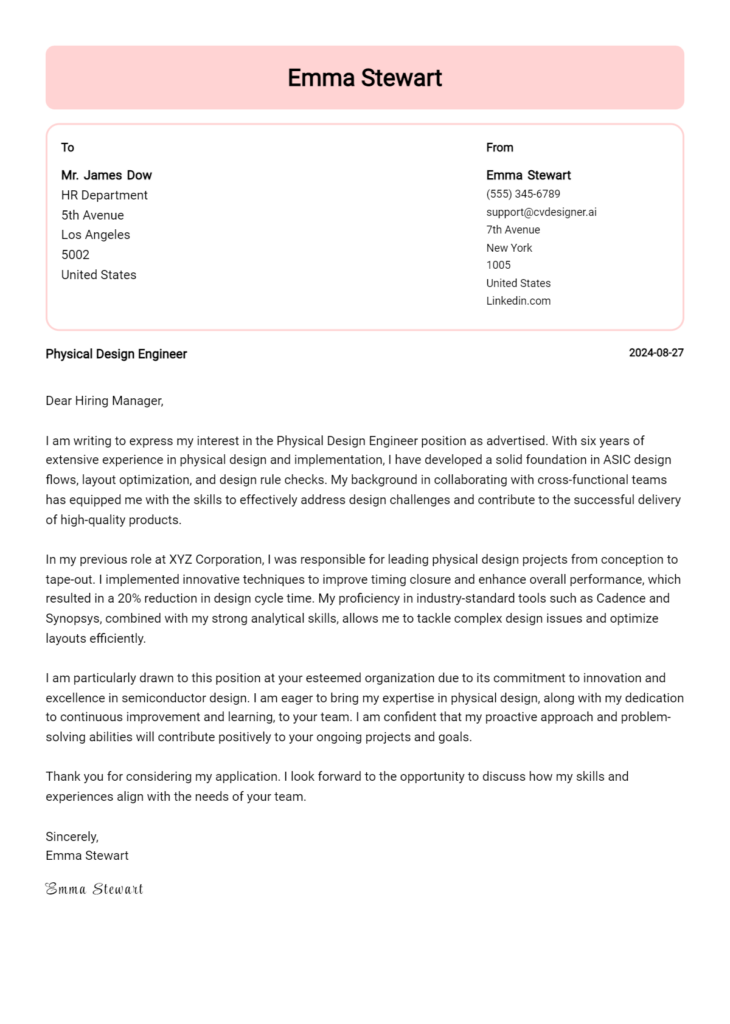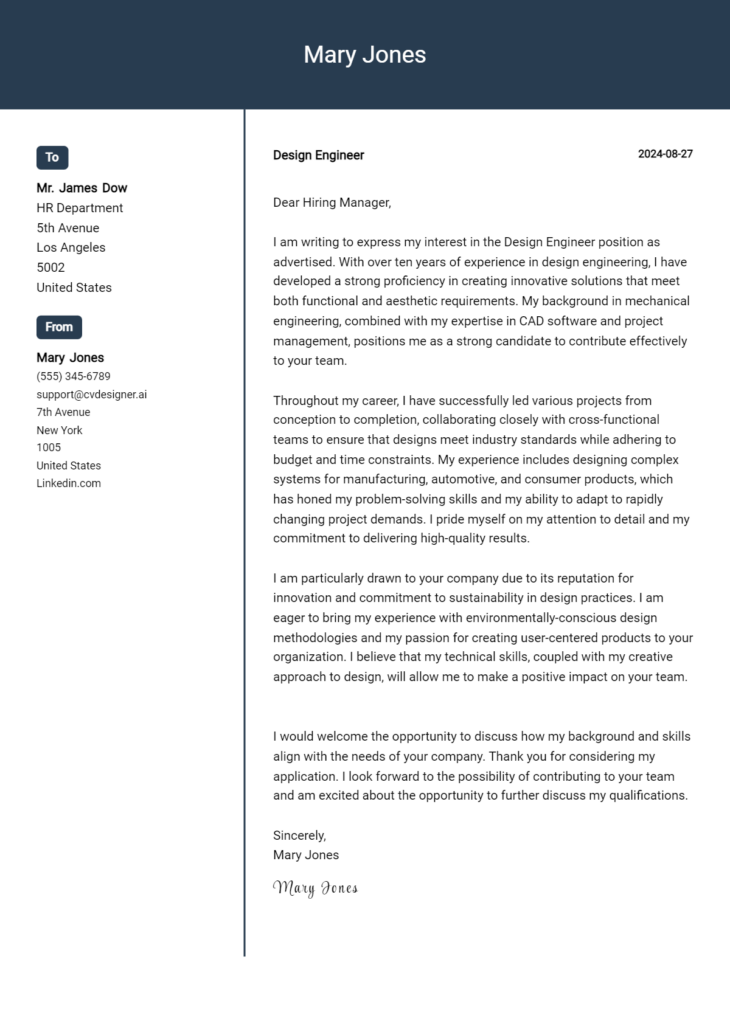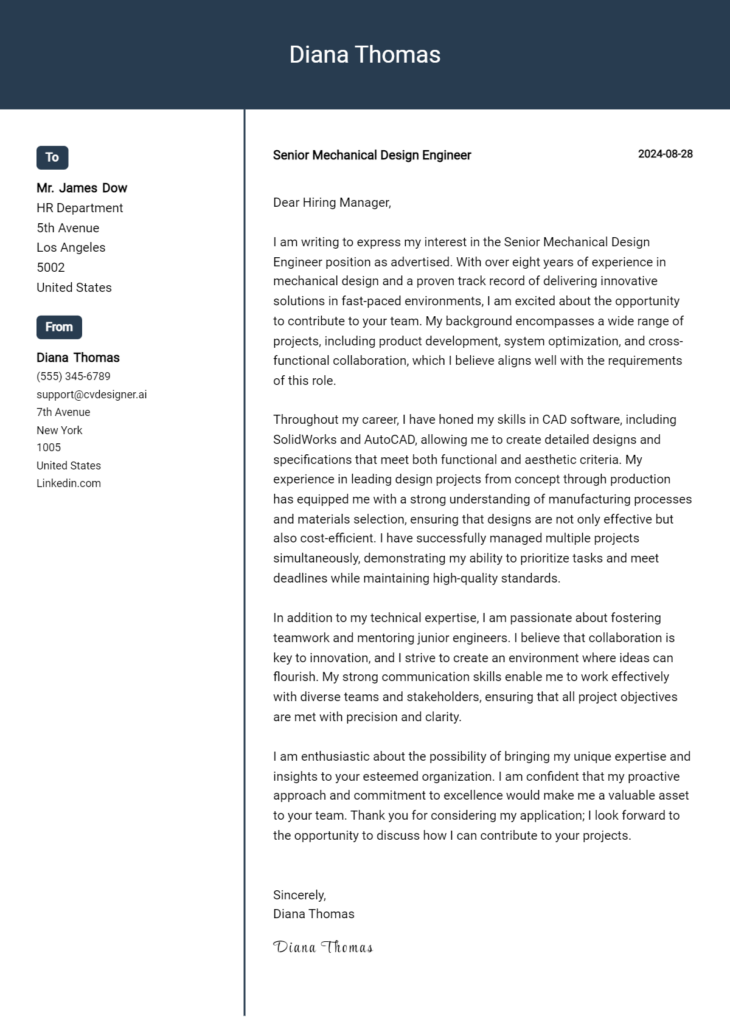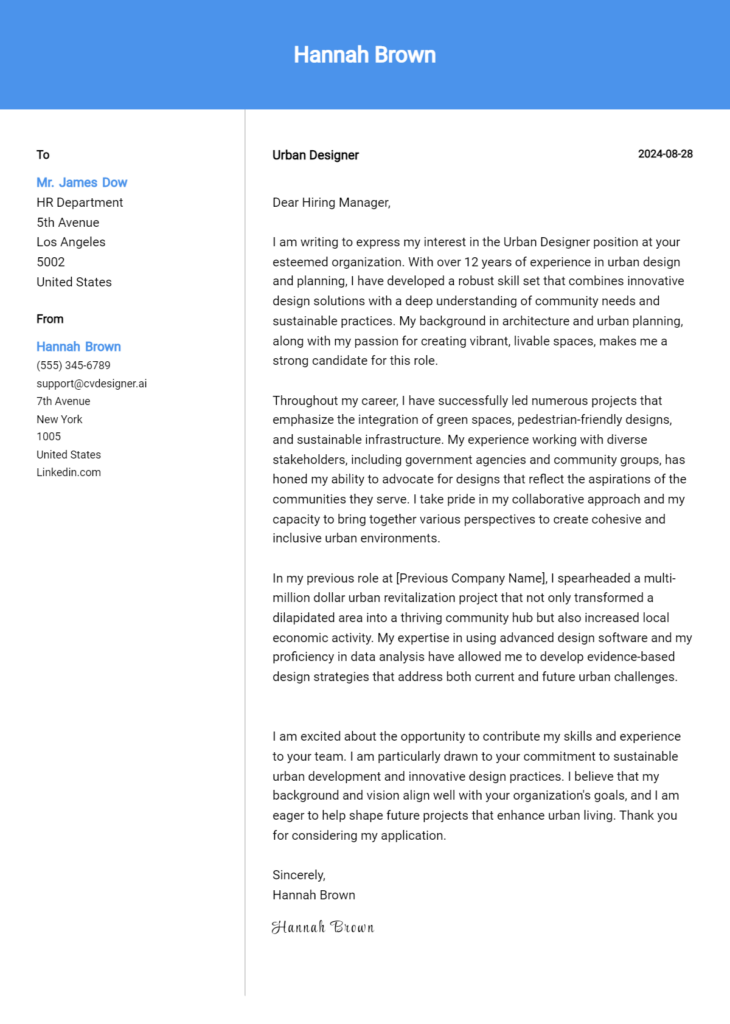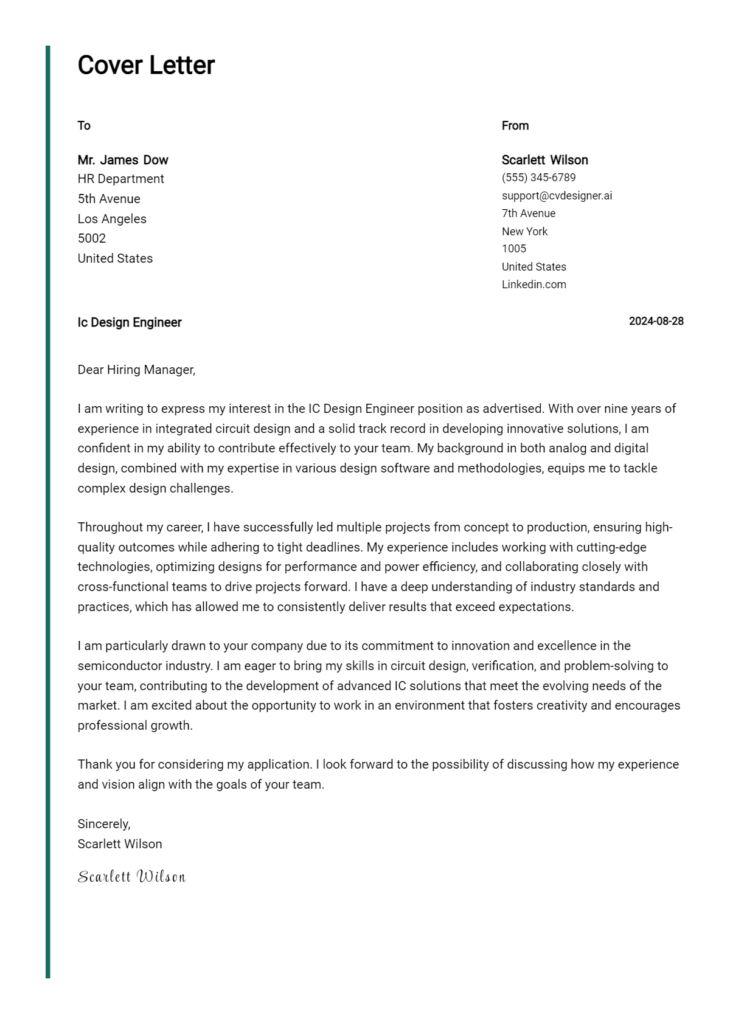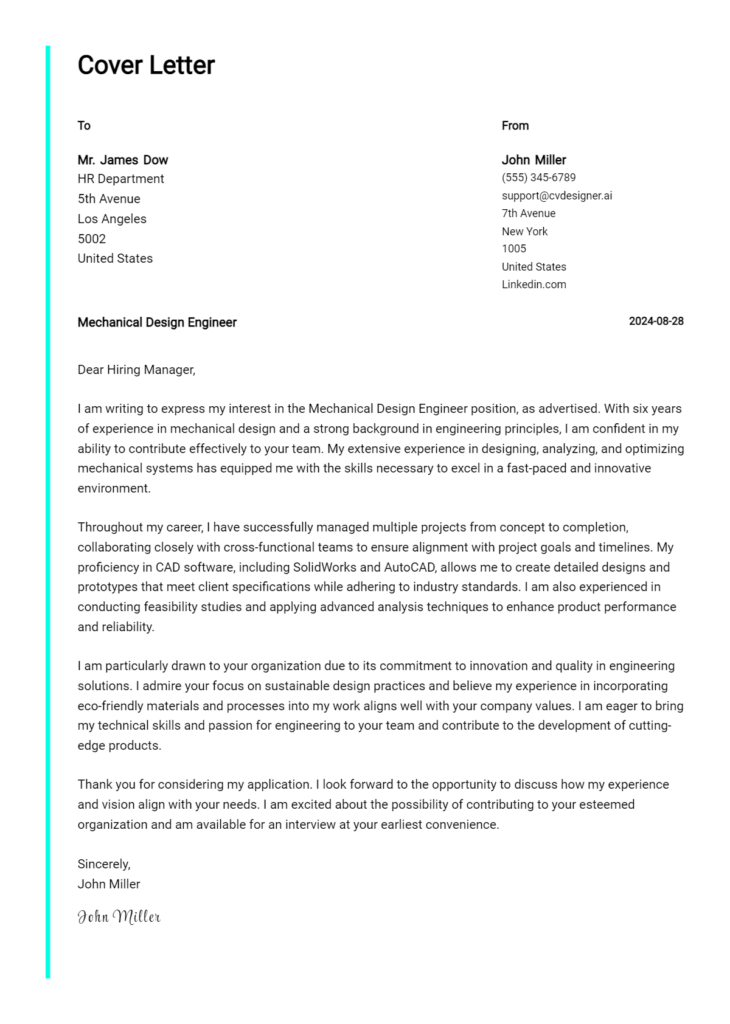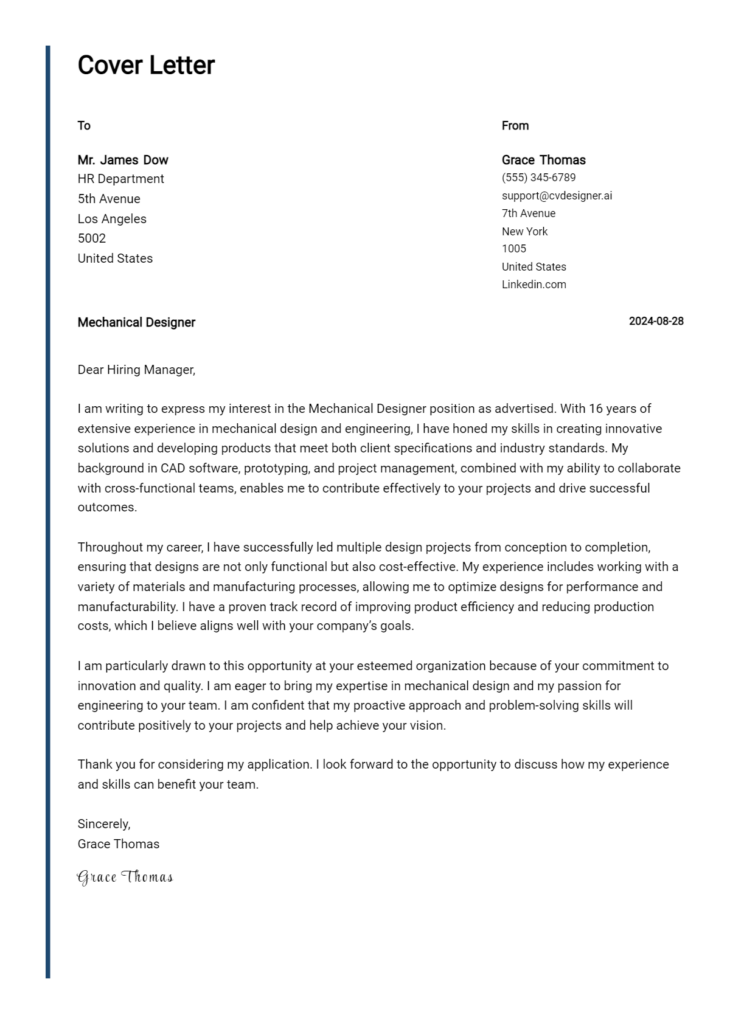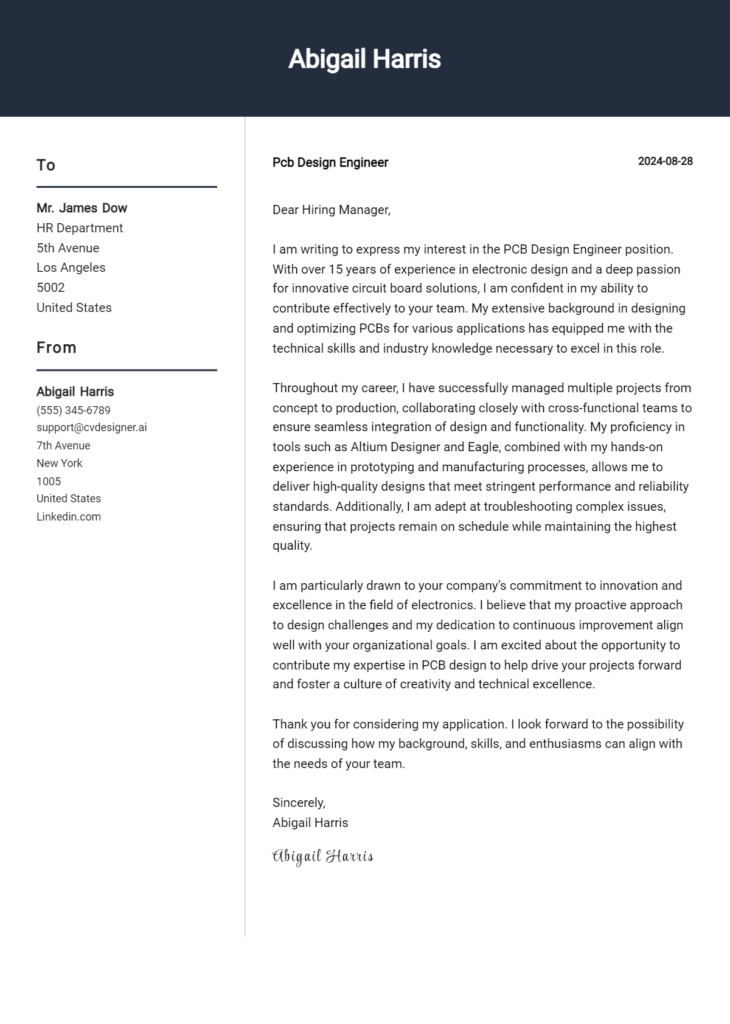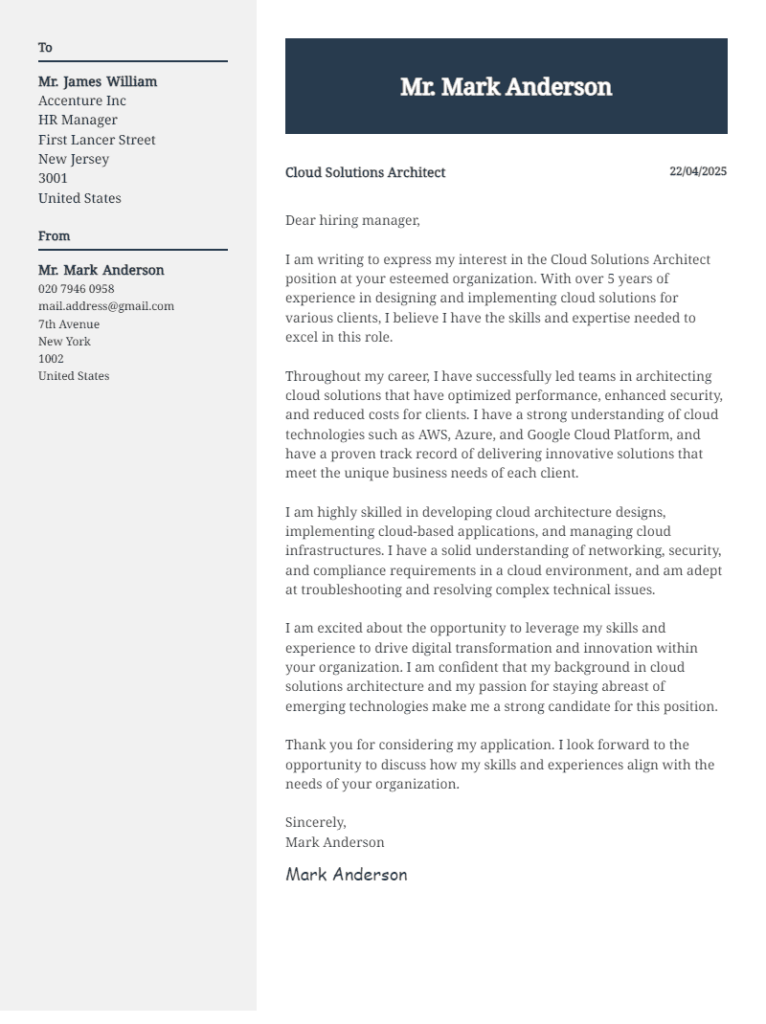Most Popular Circuit Design Engineer Cover Letter Examples
Explore additional Circuit Design Engineer cover letter samples and guides and see what works for your level of experience or role.
As a Circuit Design Engineer, your cover letter is your first opportunity to make a lasting impression on potential employers. It serves not just as a formality but as a powerful tool to showcase your technical skills, relevant experiences, and passion for circuit design. In this article, we will delve into the essential elements of crafting a compelling cover letter that stands out in a competitive job market. By the end, you'll have a comprehensive understanding of how to effectively communicate your qualifications and enthusiasm for the role. Here’s what we’ll cover:
- What does a Circuit Design Engineer Cover Letter accomplish?
- Key Components of a Circuit Design Engineer Cover Letter
- Format a Circuit Design Engineer Cover Letter
- Three different level cover letter examples
- Common Mistakes to Avoid in a Circuit Design Engineer Cover Letter
- Key Takeaways
Whether you're a seasoned professional or just starting your career, this guide will equip you with the knowledge and examples needed to write a cover letter that opens doors to exciting opportunities in the field of circuit design. Let's dive in!
What does a Circuit Design Engineer Cover Letter accomplish?
A cover letter for a Circuit Design Engineer serves as a critical tool to introduce the applicant to potential employers, showcasing not only their technical skills but also their passion and understanding of the field. It allows candidates to highlight specific experiences and projects that align with the job requirements, demonstrating their capability to contribute effectively to the team. Furthermore, a well-crafted cover letter can set a candidate apart by conveying their personal brand and enthusiasm for the role, which is often not fully captured in a resume. For those seeking guidance on crafting the perfect letter, a comprehensive cover letter guide can provide valuable insights, while a cover letter builder can streamline the creation process, ensuring that all essential elements are included.
Key Components of a Circuit Design Engineer Cover Letter
- Introduction: Begin with a strong opening that clearly states the position you are applying for and where you found the job listing. This sets the tone for your cover letter and grabs the hiring manager's attention.
- Relevant Experience: Highlight your relevant experience in circuit design, including specific projects or technologies you’ve worked with. This section should demonstrate your technical skills and how they align with the job requirements.
- Technical Skills and Achievements: Discuss your technical skills in circuit design, such as proficiency with CAD software, simulation tools, or knowledge of specific circuit design methodologies. Mention any notable achievements or contributions you’ve made in past roles that showcase your expertise.
- Closing Statement: Conclude with a strong closing statement that reiterates your enthusiasm for the position and your desire to contribute to the company. Include a call to action, inviting the employer to contact you for an interview. For additional guidance, you can refer to cover letter examples and ensure your letter follows the proper cover letter format.
How to Format a Circuit Design Engineer Cover Letter
As a Circuit Design Engineer, your cover letter should effectively showcase your technical skills, relevant experience, and passion for circuit design. Below are key points to consider when formatting your cover letter:
- Start with a professional greeting, addressing the hiring manager by name if possible.
- Open with a strong introductory statement that clearly expresses your interest in the position and highlights your relevant qualifications.
- Mention your educational background, specifically any degrees or certifications in electrical engineering or related fields.
- Detail your experience with circuit design software and tools, such as Cadence, Altium, or LTspice.
- Highlight specific projects where you successfully designed and implemented circuit solutions, emphasizing your role and contributions.
- Discuss your understanding of design principles and standards, including your familiarity with industry regulations (e.g., IPC, ISO).
- Mention any hands-on experience with prototyping, testing, and troubleshooting circuits, showcasing your practical skills.
- Include examples of collaboration with cross-functional teams, demonstrating your ability to communicate technical information effectively.
- Express your commitment to continuous learning and staying updated with advancements in circuit design technology.
- Conclude with a strong closing statement, reiterating your enthusiasm for the position and your desire to contribute to the company’s success.
Circuit Design Engineer Entry-Level Cover Letter Example #1
I am writing to express my interest in the Circuit Design Engineer position at [Company Name] as advertised on [where you found the job listing]. With a Bachelor’s degree in Electrical Engineering from [Your University] and hands-on experience gained through internships and academic projects, I am excited about the opportunity to contribute to your team and further develop my skills in circuit design.
During my academic career, I completed several projects that provided me with a strong foundation in circuit design principles and practices. One notable project involved designing a low-pass filter for a sound system, where I utilized simulation tools such as LTspice to analyze the circuit's performance. This experience not only honed my technical skills but also taught me the importance of precision and attention to detail in circuit design. Additionally, I collaborated with a team to create a prototype of a microcontroller-based system for home automation, which enhanced my ability to work in a team environment and communicate complex ideas effectively.
I also completed an internship at [Previous Company Name], where I assisted senior engineers in the development and testing of electronic circuits. I gained valuable experience in using CAD software for schematic capture and PCB layout design, as well as conducting tests to verify circuit functionality. This role gave me a practical understanding of the design process and the challenges that can arise during development, further igniting my passion for the field.
I am particularly drawn to [Company Name] because of your commitment to innovation and excellence in circuit design. I am eager to bring my strong work ethic, willingness to learn, and passion for electronics to your team. I am confident that my background and dedication will allow me to contribute positively to your projects while continuing to grow as an engineer.
Thank you for considering my application. I look forward to the opportunity to discuss how my skills and enthusiasm align with the goals of [Company Name]. I am excited about the possibility of contributing to your team and helping develop cutting-edge circuit designs that meet the needs of your clients.
Circuit Design Engineer Mid-Level Cover Letter Example #2
I am excited to apply for the Circuit Design Engineer position at [Company Name] as advertised on [where you found the job listing]. With over five years of hands-on experience in circuit design and a strong background in both analog and digital systems, I am confident in my ability to contribute effectively to your team.
In my current role at [Current Employer], I have successfully led several projects focused on the design and implementation of complex circuit systems for consumer electronics. My responsibilities have included schematic capture, simulation, and PCB layout, which have allowed me to develop a comprehensive understanding of the entire design process. One of my key projects involved the redesign of a power management circuit that improved efficiency by 20%, resulting in enhanced performance and reduced heat generation. This experience honed my problem-solving skills and reinforced the importance of collaboration across different engineering disciplines.
Additionally, I have a solid foundation in using various design software tools such as Altium Designer and Cadence, which I utilized to create efficient circuit layouts and ensure compliance with industry standards. My familiarity with manufacturing processes and DFM principles has enabled me to work closely with production teams to streamline the transition from design to fabrication, ensuring high-quality outputs and timely project delivery.
I am particularly drawn to the innovative projects at [Company Name], especially your recent advancements in [specific project or technology relevant to the company]. I am eager to bring my expertise in circuit design and my passion for cutting-edge technology to your team. I am committed to continuous learning and am excited about the opportunity to further develop my skills in a dynamic environment like yours.
Thank you for considering my application. I look forward to the opportunity to discuss how my experience and vision align with the goals of [Company Name]. I am enthusiastic about the possibility of contributing to your team and helping drive forward the exciting projects at your organization.
Circuit Design Engineer Experienced Cover Letter Example #3
I am writing to express my interest in the Circuit Design Engineer position at [Company Name], as advertised on [where you found the job listing]. With over [number] years of extensive experience in circuit design and development, I am confident in my ability to contribute effectively to your team and help drive innovative solutions that align with [Company Name]'s commitment to excellence in technology.
Throughout my career, I have successfully designed, tested, and implemented a wide range of complex electronic circuits for [specific industries or applications, e.g., telecommunications, consumer electronics, automotive]. My expertise in utilizing advanced CAD tools such as [specific software, e.g., Altium Designer, Cadence, OrCAD] has allowed me to create and optimize schematics and layouts, ensuring the highest levels of performance and reliability. At [Previous Company Name], I led a project that involved the redesign of a critical component, which resulted in a [specific achievement, e.g., 30% reduction in power consumption], ultimately enhancing the product's competitiveness in the market.
My role often requires collaboration with cross-functional teams, including software developers, mechanical engineers, and project managers. I pride myself on my ability to communicate complex technical concepts in an understandable manner, fostering a team environment that promotes innovation and problem-solving. For instance, during my tenure at [Another Previous Company Name], I initiated regular design review sessions that not only improved the design process but also significantly reduced project timelines by [percentage or time frame, e.g., 15%], demonstrating my commitment to both quality and efficiency.
Moreover, my passion for continuous learning keeps me abreast of the latest advancements in circuit design and semiconductor technology. I am particularly interested in exploring [mention any relevant technology or trend, e.g., low-power design techniques, RF circuit design], and I am eager to bring this knowledge to [Company Name]. I believe that my proactive approach and dedication to innovation will align seamlessly with your goals of delivering cutting-edge solutions.
In conclusion, I am excited about the opportunity to join [Company Name] as a Circuit Design Engineer. I am confident that my extensive experience, technical proficiency, and collaborative spirit will make a meaningful contribution to your team. Thank you for considering my application. I look forward to the possibility of discussing how my background, skills, and enthusiasms align with the needs of your organization.
Cover Letter Tips for Circuit Design Engineer
When crafting a cover letter for a Circuit Design Engineer position, it's essential to highlight both your technical skills and your problem-solving abilities. Start with a strong opening that captures the hiring manager's attention, showcasing your enthusiasm for the role and the company. Be sure to tailor your letter to the specific job description, emphasizing relevant experience in circuit design, simulation tools, and project management. Use clear and concise language to demonstrate your understanding of complex engineering concepts while also conveying your passion for innovation and collaboration. Remember to conclude with a strong closing statement that invites the reader to discuss your qualifications further.
- Tailor Your Letter: Customize your cover letter for each job application by referencing specific projects or technologies mentioned in the job description.
- Showcase Technical Skills: Highlight key technical skills relevant to circuit design, such as proficiency in CAD software, knowledge of semiconductor devices, and experience with PCB layout.
- Discuss Past Projects: Include examples of successful projects you’ve worked on, emphasizing your role and the impact of your contributions on project outcomes.
- Emphasize Problem-Solving Abilities: Describe challenges you’ve encountered in circuit design and how you approached and resolved them, showcasing your analytical skills.
- Highlight Team Collaboration: Circuit design often involves teamwork; mention experiences where you collaborated with cross-functional teams to achieve project goals.
- Keep It Concise: Aim for a one-page cover letter that is clear and direct, avoiding unnecessary jargon while still conveying your expertise.
- Use Professional Language: Maintain a formal tone throughout the letter, using professional language that reflects your understanding of the engineering field.
- Proofread Diligently: Check for typos and grammatical errors, as attention to detail is crucial in engineering roles; consider having someone else review your letter for additional feedback.
How to Start a Circuit Design Engineer Cover Letter
Certainly! Here are some examples of effective cover letter introductions for a Circuit Design Engineer:
“As a dedicated Circuit Design Engineer with over five years of experience in both analog and digital circuit design, I am excited to apply for the position at [Company Name]. My passion for innovative electronic solutions, combined with my technical expertise, makes me a strong candidate for this role.”
“With a Master’s degree in Electrical Engineering and extensive hands-on experience in circuit simulation and PCB design, I am eager to bring my skills to [Company Name] as a Circuit Design Engineer. I have a proven track record of delivering high-performance designs that meet stringent industry standards.”
“I am writing to express my interest in the Circuit Design Engineer position at [Company Name]. With a solid foundation in circuit theory and practical experience in designing complex systems, I am enthusiastic about the opportunity to contribute to your innovative projects.”
“As a results-oriented Circuit Design Engineer with a keen eye for detail and a commitment to excellence, I am excited to apply for the role at [Company Name]. My experience in developing robust electronic circuits aligns perfectly with the requirements of your team.”
“I am thrilled to submit my application for the Circuit Design Engineer position at [Company Name]. My extensive background in FPGA design and embedded systems, coupled with my passion for advancing technology, positions me as a strong asset to your engineering team.”
How to Close a Circuit Design Engineer Cover Letter
As I conclude my cover letter, I would like to express my enthusiasm for the opportunity to contribute to your team as a Circuit Design Engineer. I am confident that my skills and experiences align well with the needs of your organization, and I look forward to the possibility of discussing how I can add value to your projects.
“Thank you for considering my application. I am eager to bring my expertise in circuit design to your team and would welcome the opportunity to discuss my qualifications further.”
“I appreciate your time in reviewing my application, and I am excited about the possibility of collaborating with your team to drive innovative circuit solutions.”
“I am looking forward to the opportunity to speak with you about how my background in circuit design can support your company's goals and objectives.”
“Thank you for the opportunity to apply for this position. I am enthusiastic about the potential to contribute to your projects and hope to discuss my candidacy with you soon.”
Common Mistakes to Avoid in a Circuit Design Engineer Cover Letter
When applying for a position as a Circuit Design Engineer, your cover letter serves as a crucial tool in making a strong first impression. It should articulate your technical expertise, relevant experience, and passion for the field. However, many candidates make mistakes that can undermine their chances of landing an interview. To help you craft a compelling cover letter, here are some common pitfalls to avoid:
- Failing to customize the letter for the specific job and company.
- Using generic language or clichés that lack originality.
- Not clearly articulating relevant technical skills and experience.
- Overloading the letter with jargon without providing context or examples.
- Neglecting to highlight achievements or quantifiable results in previous roles.
- Ignoring the importance of a professional tone and format.
- Overlooking proofreading for spelling and grammatical errors.
- Being too lengthy or too brief; aim for a concise yet informative approach.
- Omitting a strong closing statement that encourages follow-up or expresses enthusiasm.
- Not including a call-to-action, such as inviting the reader to discuss your application further.
Key Takeaways for a Circuit Design Engineer Cover Letter
In conclusion, a well-crafted cover letter for a Circuit Design Engineer position should effectively highlight your technical skills, relevant experience, and passion for circuit design. Use the opportunity to showcase specific projects or accomplishments that demonstrate your proficiency in creating innovative electronic solutions. Remember to tailor your cover letter to the job description, reflecting your understanding of the employer's needs and how your background aligns with their objectives.
To streamline the process of creating a compelling cover letter, consider utilizing cover letter templates that can guide you in structuring your content effectively. Additionally, using a cover letter builder can save you time and ensure that your letter stands out in a competitive job market. With the right approach and tools, you can make a strong impression and increase your chances of landing an interview.
